Efficient handling of panels
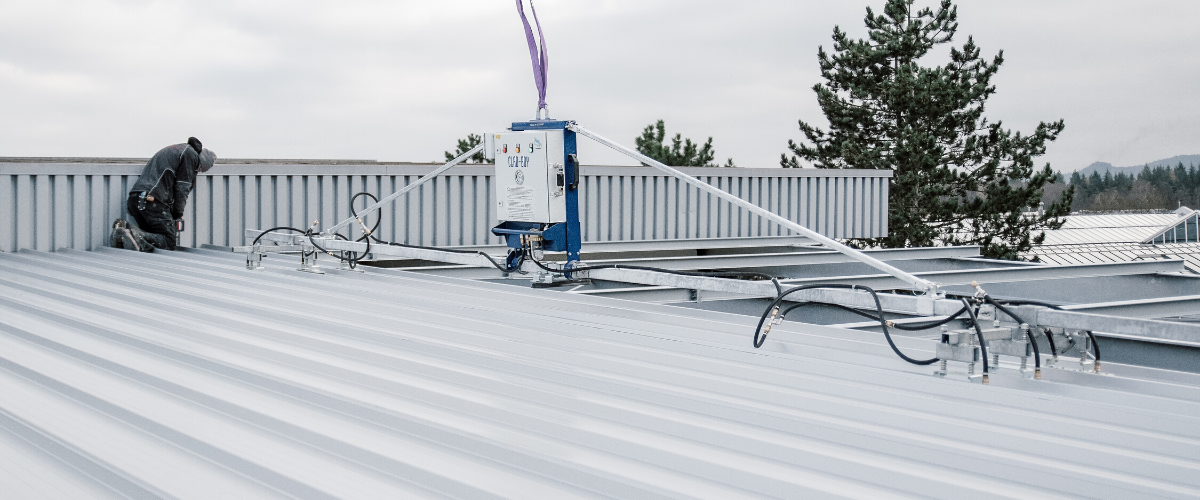
Heavy, extremely unwieldy and sensitive transport goods
Material handling is always particularly complex with sensitive but oversized transport goods. Sandwich panels or trapezoidal sheets are the classic examples of very sensitive and at the same time large-area building materials. In no direction sufficiently stiff against torsion, panels cannot be moved or even placed by hand and also rather poorly with conventional handling techniques. Moreover, depending on the manufacturer and production process, the building elements, which weigh up to 800 kg and are up to 26 m long, are usually produced without their own transport device. In some parts of the world, the situation is aggravated by the fact that, for logistical reasons, trapezoidal panels in particular are alternately packed upside down. These then have to be turned upside down again at the construction site in order to lay them.
So how do you get such monsters into the air so that they can be transported or worked on?
From other areas of material handling, the use of magnets, grippers and clamps seems logical and may even make sense for small and light sheets. But at the latest with composite building materials such as sandwich panels, clamps and the like reach their limits. In addition to damage to the workpiece, which is unavoidable with such holding mechanisms, the placement of the panels on the building is also rather awkward. Since the holding mechanism has to be released before the workpiece is in its actual place, there is no need to carry out power-intensive rework when installing the panels.
Optimum handling solutions for construction site use
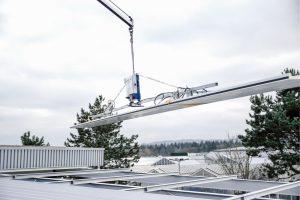
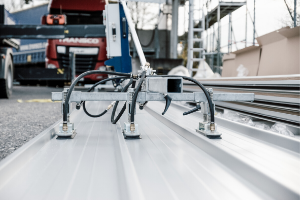
These circumstances are often enough a source of security risks and inefficiency. It is precisely at this point that optimized systems and equipment for material handling ensure the necessary balance between the required quality and humanly affordable requirements. Handling solutions with vacuum technology are ideally suited for use on building sites in facade and hall construction. In addition to the obvious benefits of extremely gentle transport of sandwich panels and boards, the main focus is on significantly higher safety for users and increased productivity. Using vacuum, the goods to be transported are sucked on their surface and held on the lifting device under process control. The workpiece is only touched and not gripped. The surface of the workpiece is not mechanically affected and can be "touched" without damage. This benefit becomes particularly clear when composite materials with low inherent stability are used or glass is used for cladding on facades. Handling devices for use on the construction site are perfectly suited for panels and sheet material for building cladding in order to bring them conveniently to the desired location. Whether for the installation of halls with panels up to 26 m on roofs or walls or for the cladding of buildings with different materials such as glass, trapezoidal sheets or composite building materials - in any case, handling devices with vacuum technology are the optimal solution. In addition to their significant increase in safety, the construction site helpers also stand out for their deliberately reduced design. The main focus of these solutions is to extend the services of employees on construction sites and to make manual handling tasks easier and more relaxed by technical means. The depalletising of transported goods or turning panels before transporting them to the site is no longer an energy-sapping challenge, but a normal part of laying work. The advantage of handling with vacuum technology becomes particularly clear when looking at the actual installation of panels and facade elements. Here, in comparison to conventional transport methods, the workpiece can be held permanently at its installation location until the anchoring with the building is completely finished. The lifting device permanently secures the transported goods and can be moved if necessary to position the workpiece correctly. At the same time, the vacuum lifter's safety feature ensures more efficient work processes for employees, since the transport is already perceived as part of the assembly process, so the focus is on the actual installation of the panels and not on the safe transport and placement. These features promise a significant increase in productivity while reducing safety risks at the same time.
Relaxed and gentle handling reduces risks and increases productivity
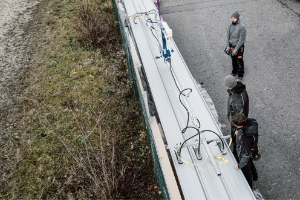
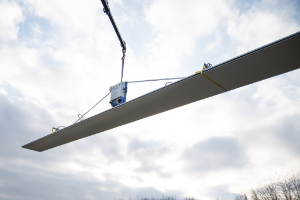
Depending on the complexity of the construction project, further advantages of handling solutions with vacuum technology come into play. For example, most of our panel handling devices can be flexibly converted to different fields of application. For example, panels can be placed on roofs with an inclination of up to 45°, and cladding can be installed on walls and facades. Thanks to the flexible mechanisms for aligning the suction plates and traverses, the CLAD-BOY® makes almost any requirement manageable. The CLAD-BOY® can be configured for both vertical and diagonal installation of wall panels. Nothing stands in the way of quick conversion on the construction site by means of simple plug connections, even for the installation of roof panels. Different suction plate gaskets and the option for e.g. pendulum suspension of the suction plates make even the most difficult profile transportable, even with a very creative trapezoidal structure. The CLAD-MAN® is just as variable, but can carry much more and is therefore particularly suitable for large hall buildings or far-reaching facades. The CLAD-BOARD is also suitable for the universal installation of smaller areas and the CLAD-TEC is the best choice for glass surfaces or windows due to its four separate suction circuits, which offer the highest level of safety.
In view of the speed required at the beginning, such systems offer solutions for the most diverse requirements when laying boards, claddings and panels. With these handling devices, safety for employees and transported goods is automatically increased by the intended specific use. At the same time, productivity is increased both by reducing the physical effort and by systematising work steps.
Testing handling solutions for hall construction live
Are you familiar with these questions and do you want to advance your company in the execution of such services?
Visit us at Dach+Holz 2020 and we invite you to test your possible future handling solution at our booth 101A in hall 9. Our expert consultants will be pleased to support you with suitable solutions for your construction projects.
Make your personal appointment now.